A tour through my machine room
Note: this is a work in (slooooow) progress. More text to come in the future.
Truly.
I also plan to have much more pictures, especially the inners of some
very interesting machines, but this won't come until several months, since I do
not have a digital camera to take snapshots and am relying on friends dropping
by to get new pictures.
So, if you're really eager to see more pictures
there, and own a digital camera, feel free to drop by...
Also, most
of these pictures are fairly old now (december 1999). There are more machines in
the room, some have moved, but the general idea is the same. It's just not as
much impressive as it is now.
A quick tour through the machine room
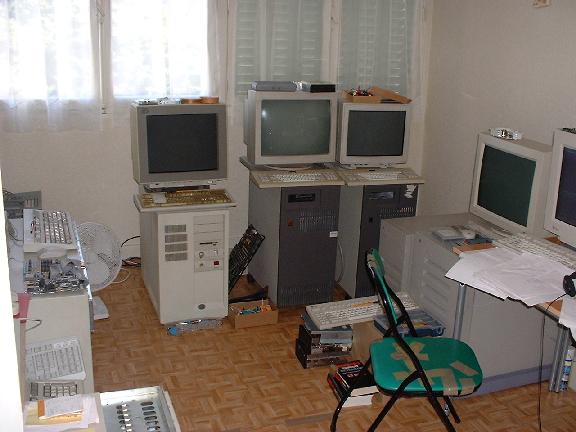 |
When you stand behind the door, here are the first few machines
you'll see. The door being located near the left wall of the room, a line
of big VME crates, with a few smaller machines in between and lots of
stuff layed on them, goes from the opened door to the windows. Then, under
the windows, a row of even bigger cases, each one with a huge monitor on
it. The right wall is partly hidden by the table which supports two
monitors, altough you can guess the presence of two grey cases between the
table and the windows. Don't forget to have a merciful look at the, well,
tired, chair.
|
 |
You only have seen a small third of all the systems lying here...
If you bend down, you'll see there is a tower of boxen under the
table...
|
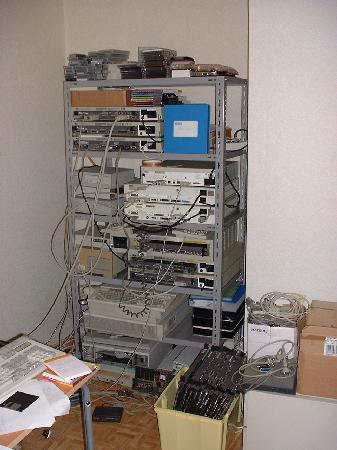 |
However, you can't see half of the machines until you've moved one
step forward, since the tower of babel lies in a small recess. Oh, and by
the way, the beige table to the right of the yellow VME card box is not a
table, but a machine...
Oh, and notice this blue square with a
shorter white square in it? This is a 8 inch diskettes box, from Digital.
It contains original diskettes for VMS version 1.6, no less, dated '80.
VMS version 1 was still a prototype, and was only a 16 bit system - the
real VMS started with version 2, was 32 bit, and used the full potential
of the VAX systems. VMS 1.x was not even self-contained, and had to boot
from RSX-11/M running in PDP-11 compatibility mode on the VAX 11/780.
There is also the Fortran compiler in the box. The sad thing is that I
don't know if the diskettes are still in good shape (they were still
readable about 6 years ago), so if anyone has a VAX 11/780 with a diskette
drive cabinet, I'd love to test these diskettes
again...
|
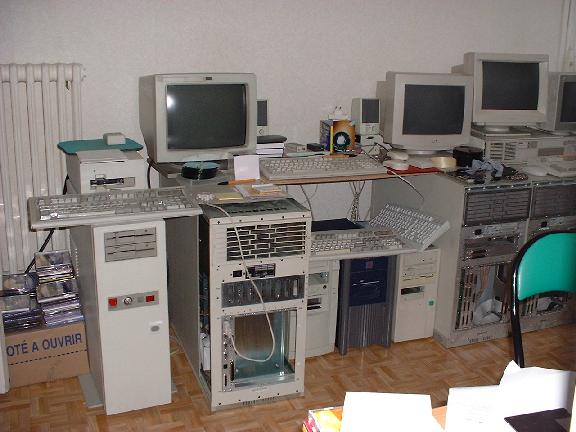 |
Turn back to face the left wall. The topleft machine is an IBM
RT/PC (better known as ``romp''), the predecessor of the RS/6000 line
of workstations. Notice the BeBox between the two peecees. Also, due to the weird
(lack of) organization here, some machines have to share power cords until
I decide to go buy some more, that's why none of the visible mvme crates
was plugged when this pictures were taken.
|
At the time those pictures were taken, the machine room was hosting 41
machines, 5 of them awaiting maintainence, or arrival of spare parts. Nowadays,
there are 51 machines there, only 3 still in non-working shape, but several VME
cards share the same backplane. If you add the machines awaiting to be cleaned
and set up, and the machines sleeping in the cave, there are 74 machines in my
collection, and 8 in non-working condition. That surely accounts for some
madness...
The Attic
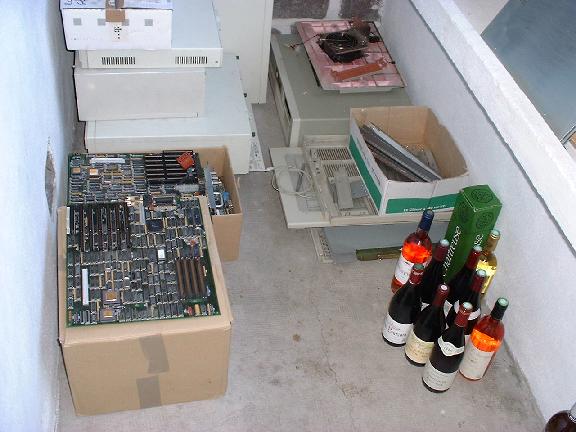 |
Well, everything doesn't fit in the machine room. Some unused or
defective parts lie in one attic, and I keep some monitors in the cave,
too, to save some space here.
So, here you can see two Apollo DN3500
motherboards over two boxes of other Apollo cards. Behind them, a pile
made of an IBM XStation 130 cheapo X terminal, a memoryless RS/6000 model
320, an empty shoebox (Sun case model 511), another XStation 130, and a
box full of IBM RT/PC parts on top. Behind them, lying on the backwall, an
empty RT/PC tower (6150) case.
To the right, the bottles of french
wines and liquors are definitely not afraid of their neighbours (-:
The
picture is particulary wrong, because on the average there are much more
bottles in the right side of the attic.
|
More information on selected systems
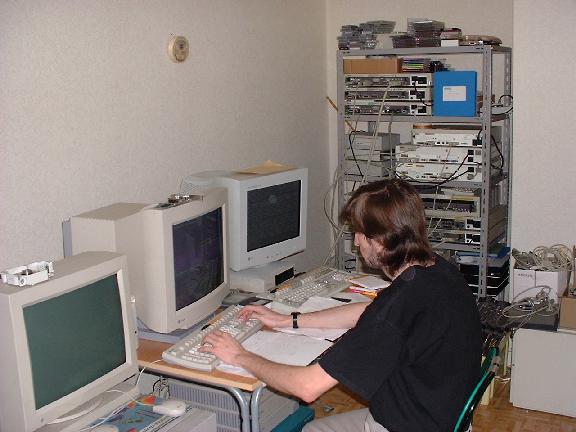 |
This image used to be a proof the chair, although very damaged,
didn't collapse under me yet... Unfortunately this is not true anymore, it
was so damaged that I preferred to get rid of it. I am now sitting on a
footstool, with a small cushion on it.
Some people have been asking
about the beige thingie you can see across the wall was. Some even were
correct in their guesses. It's the top part of a ``Livarot'' box, a
delicious French cheese. |
 |
I am really fond of the ``romp'' machines. Perhaps because I
learned Unix on such machines (and on sun3 boxens, as well). This
architecture was well thought for the time (back in '81) - unfortunately,
because of the PC market, IBM did not decide to sell these machines until
'86, and they were outperformed by several other vendors at this time. I
sometimes think that if IBM had sold these machines back since '81, it
would be at the place Sun is now.
The main drawback of the romp, is
that it is limited to 16MB of physical memory (24 bit addressing). The
second one is that it uses the ISA bus, but there were not many
alternatives in the early '80s, Multibus and VME excepted. Plus, you could
theoretically plug any ISA card and it would work - if you had also a
driver for it, of course. That's why, although the romp came with its own
video boards and completely awesome connectors for video, keyboard and
mouse, you could have one running with a cheap EGA card and SCSI drives
instead of ESDI, using an Adaptec ISA controller.
The processor itself
is a ``first-generation'' state of the art RISC design, although with not
enough general registers (only 16) to be really fun to program. And delay
slots, for sure. I am still amazed at the raw CPU power, which is several
times better than any 68020 or 68030 running at the same frequency.
However, bus accesses are awfully slow, and cut the performance a
lot.
The fancy mouth over the keyboard is an SCSI QIC-150 tape driver,
loaded with a tape but not locked. The tape contains a compressed backup
of the machine, and with the bootable diskette in the top 5"1/4 diskette
drive, the machine is ready to be reinstalled. Unfortunately IBM choose to
use a specific one-target-only SCSI controller with a NiH cable, so you
can't use anything but their tape drives on it. For the record, I have
both the QIC-150 and the QIC-24 tape drives in working shape, the latter
being very rare but mostly useless due to its small capacity.
|
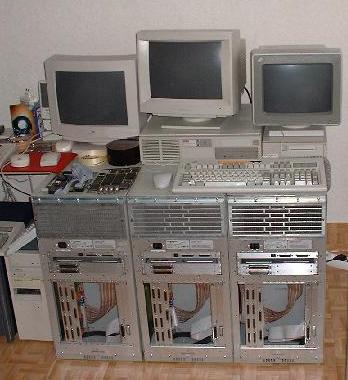 |
The three huge and heavy Motorola 8640 cases provide a very
convenient table to put the monitors connected to the peecees and the
BeBox to their left. Each of them contains a dual-processor MVME188
system, with two SCSI controllers, 12 serial ports, 128 MB of memory, and
faulty network cards. Hopefully, with such a number of serial ports, you
can network using SLIP, but it's not as fast as I'd like it to be.
Over
them, the slow AlphaStation used to be my FreeBSD test machine. Nowadays I
don't run FreeBSD anymore, though... but this machine is still a test
machine (-:
The 8mm exabyte tape drive to the right is only here for
the small (but dense!) 12 inch IBM monitor to fit... |
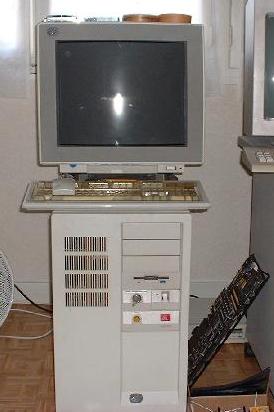 |
This specific model of case, common to all the 5x0 RS/6000 models,
is pretty weird. The internal SCSI cable is more than 2 meters long, and
has more connectors you will ever be able to use (i.e. more than 16). Yet,
external SCSI-1 devices happen to work, if you use active terminators
everywhere.
I hope to be able to take pictures of its inners. The 3
part planar is soooo cool! But not as cool as some of its mca extension
cards, such as the SCSI controller, on which you can count more wires
strapped than ICs soldered...
In the back, you can guess the presence
of an external cdrom drive (more easy to spot on the next
picture).
The black crosswise thing used to be an Hewlett-Packard
400t motherboard. It was intended to be a spare part, should my 425t mobo
fail, but I accidentally broke the spare, so, no gain.
|
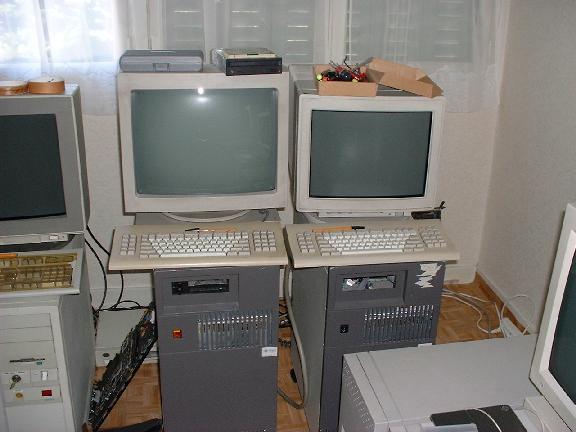 |
Aren't such big, heavy screens a nice place to put stuff on top of
them? Especially opened screwdrivers boxes...
The left crate, a sun
3/160, was bought by the French army in 1987, and used until the mid
nineties. Then its disks were physically destroyed, and the remaining
parts were picked up by the local sysadmin, who eventually left it to me.
It's still running diskless, but its main purpose is, of course, of being
a space heater, a bit too noisy however.
The other crate is most of the
time a sun 3/260, but I sometimes run a sun 4/260 (the first sparc model,
ever) in it, since both motherboards share the same memory boards. The
sun4 runs diskless, while the sun3 runs off a small (capacitywise) esdi
drive. I traced back the history of the 3/260 back to a nuclear power
station, where it was used for around ten years, with an added mvme135
embedded system, for watergate control...
Since then, I have found
another backplane to run the 4/260 in, so I don't have to share backplanes
anymore. I also found a cabinet of SMD disks, for a whopping 2x380MB, and
about 40lbs per disk drive... The not fun part is that, if the two disks
spin up at the same time, this usually blows a breaker...
|
 |
Those gray crates are the next generation of Sun's VME machines. I
am still really upset that the x30 crates (the small one to the left) is
not as tall and as depth as the x70 crates (well, the big one to the
right).
So, the left one usually contains a Sun 4/330, which also
serves as my VME test machine, when it comes to work or test 9U VME cards.
The right one is a Sun 4/670, a quad-processor (yet slow) sparc machine
with two SM100 CPU modules, each module featuring two 40 MHz Cypress
processors. I really like the way the x70 cabinets is organized, with the
four 5"1/4 inch drive bays at the top (two of them having front access,
which lets you for example have one half-height cdrom drive, one
half-height QIC-150 or DAT drive, and one full height or two half-height
8mm tape drives accessible from the front panel)... |
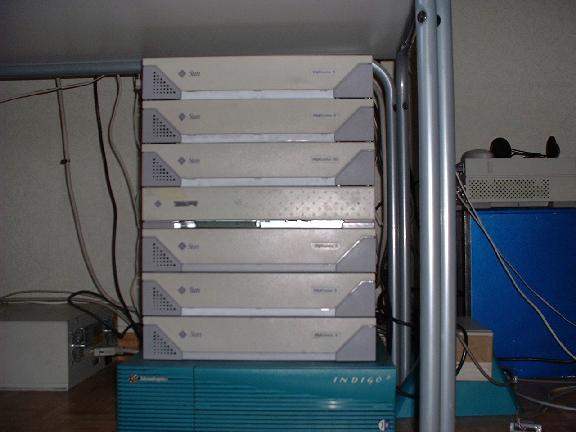 |
The lowest machine of the pile is a fast (for my standards) SGI
Indigo2 with a 200MHz R4400 CPU. Not as fast as the R10K upgrades, but
then I keep the IP22 compatibility and get a very nice speed. I mainly use
it as the netscape + acroread machine under IRIX, but I am also very fond
of some OpenGL screen savers, although I don't see them very often. I also
listen to modules on it.
The lower half of the sparc pile used to be my
main three servers as well as my main desktop machine; they now occupy a
specific set of shelves besides the table, so that I can put my feet under
the table without hitting them. The upper two were sold a few weeks after
this picture was taken, but I have about 10 sparc machines left in the
cave, some of them awaiting their NVRAM upgrades, some even in working
shape, that I will either keep as test machines or give out to good
friends...
|
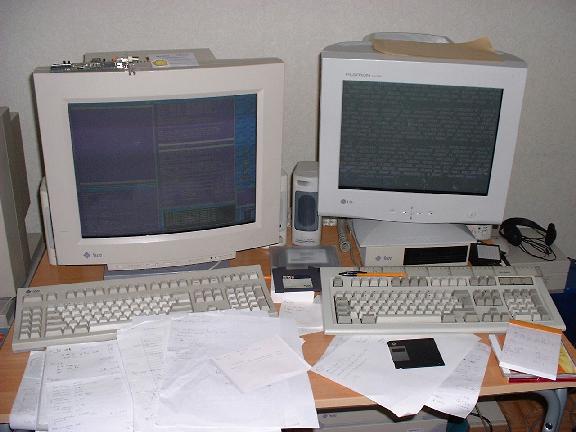 |
This used to be what my workplace looked like about two years ago.
Nowadays, the left screen is the SGI screen of either the Indy (which was
not there yet when the pictures were taken) or the Indigo2. The right
screen is now the sparc screen of my main workstation (SparcStation
5/110), which is left on the picture. The right screen of the picture,
usually connected to the blue alpha, is still in service, but is now to my
right, since I don't need to watch it as often as I watch the other
two.
Both keyboards carry the DVORAK keyboard layout. I used to suffer
from wrist injuries about 10 years ago, and since I have switched to the
DVORAK keyboard layout, not only do I don't suffer anymore, but I also
type much faster.
The small black surface under the right screen is a
DAT drive, which I use for my regular backups. Don't you also backup your
data at regular, short, intervals? You should. |
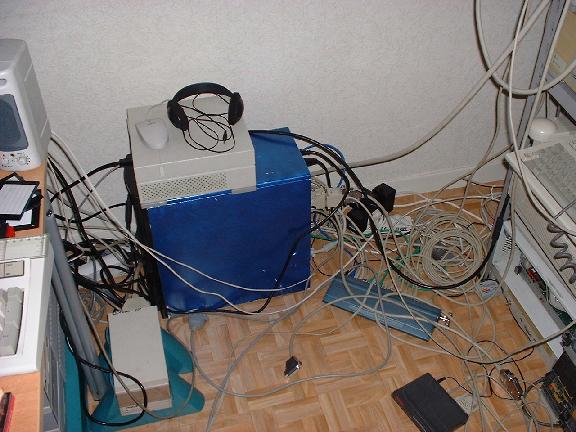 |
What a mess here. The blue box is an alpha 164LX that I built
myself after buying the mobo and accessories at a reduced cost when I used
to work for Digital. I used a regular PC case for it, with a strong power
supply though, and to make the machine different from the common ugly
beige found everywhere, I painted the box in blue, except for the front,
which I painted in black (front drives bezels included).
The small
lunchbox over the alpha is a small, slow, silent, cute SparcStation IPC.
Slow as hell, but this one has a long story. Very shortly, I used to
sometimes work on this machine when I was still a student ages ago. A long
story of weird facts eventually put it in my hands, and I did not realize
I had used this machine in the past until I recognized the ethernet
address of the built-in controller...
There used to be a lot of
knots in the cable madness there, eh? I eventually cleaned this area,
though, and now most of the cables have no knots and are suspended above
the ground. This is much much better when it comes to clean the room.
|
Last update: Wed Dec 26 00:09:53 GMT 2001
Images courtesy of Brice
Cazaux.
miod@online.fr












